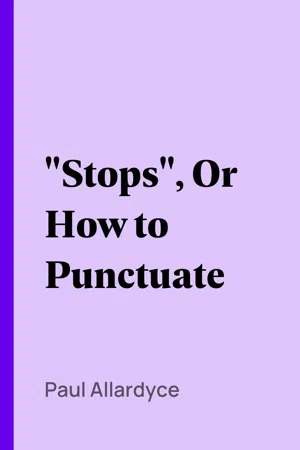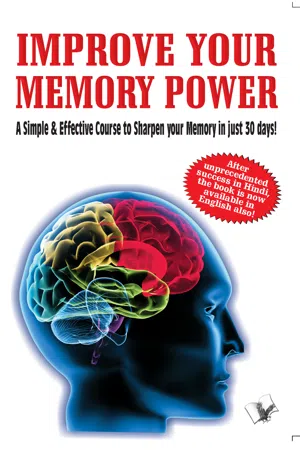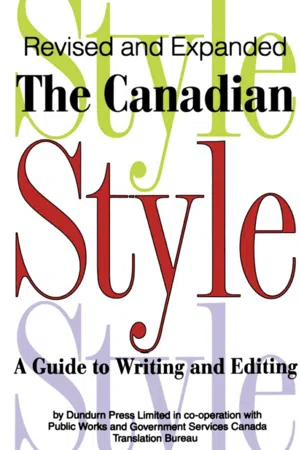Inverted commas
Inverted commas, also known as quotation marks, are punctuation marks used to indicate direct speech, a quotation, or to highlight a specific word or phrase. In English, they are typically represented by double quotation marks (" ") or single quotation marks (' '). Inverted commas help to distinguish quoted text from the surrounding content and are an important tool in written communication.
5 Key excerpts on "Inverted commas"
- eBook - ePub
"Stops", Or How to Punctuate
A Practical Handbook for Writers and Students
- Paul Allardyce(Author)
- 2007(Publication Date)
- Perlego(Publisher)
...By using them we call special attention to the fact that these were the words actually employed, and are not simply words like them. So, in a passage quoted in the indirect form, if part be quoted exactly, it is placed within Inverted commas. The Duke of Portland warmly approved of the work, but justly remarked that the king was not "so absolute a thing of straw" as he was represented in it. Words referred to simply as words are either placed within Inverted commas or put in italics. The word "friendship," in the sense we commonly mean by it, is not so much as named in the New Testament. LIV. When a quotation is interrupted, as in the report of a conversation, each continuous part of the quotation is enclosed within Inverted commas. "Pardon me, madam," answered Henry, "it was of one Silas Morton I spoke." LV. When a quotation occurs in another quotation, single Inverted commas are used for the former. "What have you done?" said one of Balfour's brother officers. "My duty," said Balfour firmly. "Is it not written, 'Thou shalt be zealous even to slaying'?" Some writers use the single commas in ordinary cases. For the inner quotation they would then use the double commas. LVI. A word that is not classical English, or is used in a sense in which it is not classical English, is either enclosed within Inverted commas or italicized. Those that have "located" (located) previous to this period are left in undisputed possession, provided they have improved the land. Before long, Beckey received not only "the best" foreigners (as the phrase is in our noble and admirable society slang), but some of "the best" English people too. Foreign words are always italicized. (Rule LXIV.) LVII...
- eBook - ePub
Improve Your Word Power
A concise way to increase your word power
- Clifford Sawhney(Author)
- 2018(Publication Date)
- V&S Publishers(Publisher)
...Quotation marks are used either to mark the beginning and end of quotation or title, or to indicate slang usage or words that are jargon. The most common use is to tell the reader the exact words spoken by a person, which is called a direct quotation. For instance: He told me, “I will come to work an hour late today.” The above sentence is a direct quote. As an indirect quote it would be stated in this way: He told me that he would come to work an hour late today. In the above example, the quotation marks are not used since it is an indirect statement. Although both sentences convey exactly the same meaning, in the first instance they tell the reader that the person quoted has spoken directly. In common writing, only the double quotation mark is used. However, in the print media, the double and single quotation marks are both used, depending on the context. The usage in Britain and America differs, but we shall restrict ourselves to the usage in India, where double quotes are almost always used to indicate direct speech. Single quotes are usually used to indicate a quote within a quote or to indicate that the person quoted has expressed a sentiment mentally rather than verbally. For instance: “Shweta told me, ‘Why should I help you out,’” Ramesh informed Harish. In the above sentence, Ramesh speaks directly to Harish and tells him what Shweta told him. Therefore, Ramesh’s words are used in double quotation marks, while Shweta’s directly quoted words are used in single quotation marks. The simple rule of thumb is that if the direct quotes are in double quotation marks, any quote within this quote will then be in single quotation marks...
- eBook - ePub
The Canadian Style
A Guide to Writing and Editing
- Public Works and Government Services Canada Translation Bureau, Dundurn Press Limited(Authors)
- 1997(Publication Date)
- Dundurn Press(Publisher)
...Chapter Eight Quotations and quotation marks 8.01 Introduction 8.02 Run-in format 8.03 Punctuation and grammar in run-in quotations 8.04 Indirect (reported) speech 8.05 Paragraphing: run-in format 8.06 Block format 8.07 Paragraphing: block format 8.08 Quotations within quotations 8.09 Omissions 8.10 Insertions, alterations and parentheses 8.11 Reference to words as such 8.12 Words used in an ironic or special sense; slang and technical terms 8.13 Titles 8.14 French and foreign-language quotations 8.15 Abuse of quotation marks 8 Quotations and Quotation Marks 8.01 Introduction The main use of quotation marks is to set off the exact words of a speaker or written source from the main body of a text. The quotation may consist of one or more complete sentences or paragraphs, parts of a sentence or paragraph or as little as one word. As an alternative to the use of quotation marks in the run-in format (quotations integrated into the text), direct quotations may be indicated by means of indention and/or reduced leading (space between lines) or font size, called the block format. Whichever format is adopted, the quoted matter should normally be faithfully reproduced in every detail: the spelling, punctuation and other characteristics of the original may not be changed without good reason (see 8.10 for information on insertions in and alterations to quoted matter). Bear in mind, too, that the excessive use of quotations can mar the appearance of a page and make it difficult for the reader to follow the ideas being presented; it is often better to paraphrase, use indirect speech or give a summary of the ideas concerned in your own words—in each instance accompanied by a footnote providing the source of information...
- eBook - ePub
Write to the Point
A Master Class on the Fundamentals of Writing for Any Purpose
- Sam Leith(Author)
- 2018(Publication Date)
- The Experiment(Publisher)
...But it also means that often you’ll be forced to use a large and unwieldy chunk of text (so that it’s grammatical on its own), and you’ll have less chance to direct your reader to the important parts. Very often you’ll want to quote only one or two words from something. That almost always means using reported speech. If someone delivers a dull and rambling forty-six-word sentence at his wedding in which he describes it as “the best night ever,” economy will often ask you to say something like, “He described it as ‘the best night ever,’” rather than quoting the whole shebang at length. That’s why the grammar-integration rule is important to understand. As well as punctuating direct quotation, quote marks can be used to make clear you’re introducing a new or unfamiliar term. For instance: The fancy word for an invented word is “neologism.” You can also use quote marks to make clear that a particular usage or form of words (rather than, say, the specific words of a particular individual) is being used but not necessarily adopted by the author. It’s a way, in other words, of preserving the author’s neutrality. Yesterday marked the opening day of “the greatest show on earth.” We’re seeing the first legislative efforts to make “compassionate conservatism” a reality. As an extension or distortion of that function, quote marks are sometimes used to indicate active skepticism, sarcasm, or a certain archness of tone. In that role they’re sometimes called “scare quotes.” These are the on-the-page equivalent of making rabbit ears in the air with your fingers when saying something you consider distasteful or absurd. My nephew had me drive him to a “rave party.” I had the misfortune before I left to see him start “dancing.” The homeopath I met at the party was very keen on “alternative medicine.” These should be used with great caution. Scare quotes—particularly applied to relatively well-established usages—more often than not make the author seem sneering or fuddy-duddy...
- eBook - ePub
Students Must Write
A Guide to Better Writing in Coursework and Examinations
- Robert Barrass(Author)
- 2005(Publication Date)
- Routledge(Publisher)
...Any gaps in the quotation should be indicated (by three dots, preceded and followed by a space, as on page) and any words you insert in a quotation (for clarification, further explanation, or to summarise) must be in square brackets (as on page). The source of each quotation should normally be acknowledged (see page), unless you have some good reason for not doing so (for example, see page). Do not use quotation marks (Inverted commas) to indicate that a word or phrase is not to be understood in its usual sense, because if you do the intended sense may not be clear to the reader. Instead, choose words that convey your meaning precisely (see page). The titles of books, plays and poems should not be marked by quotation marks, as is sometimes recommended, but in handwriting by underlining and in print by italics (or underlining).Use underlining or italics to help you distinguish, for example, between David Copperfield (the name of a character in a book) and David Copperfield (the title of a book). Improve your writing The best way to appreciate the usefulness of different punctuation marks is to study one or two pages of any book or article that interests you. Consider why the author has used each punctuation mark. You can repeat this exercise with as many compositions as you choose to study. In writing clear and simple English you can manage without semicolons and colons, but as you begin to appreciate their value you will want to use them. Your writing, including your punctuation and spelling, will also improve – without your making any conscious effort to improve it – if you read well-written books and newspapers regularly for enlightenment and pleasure....




